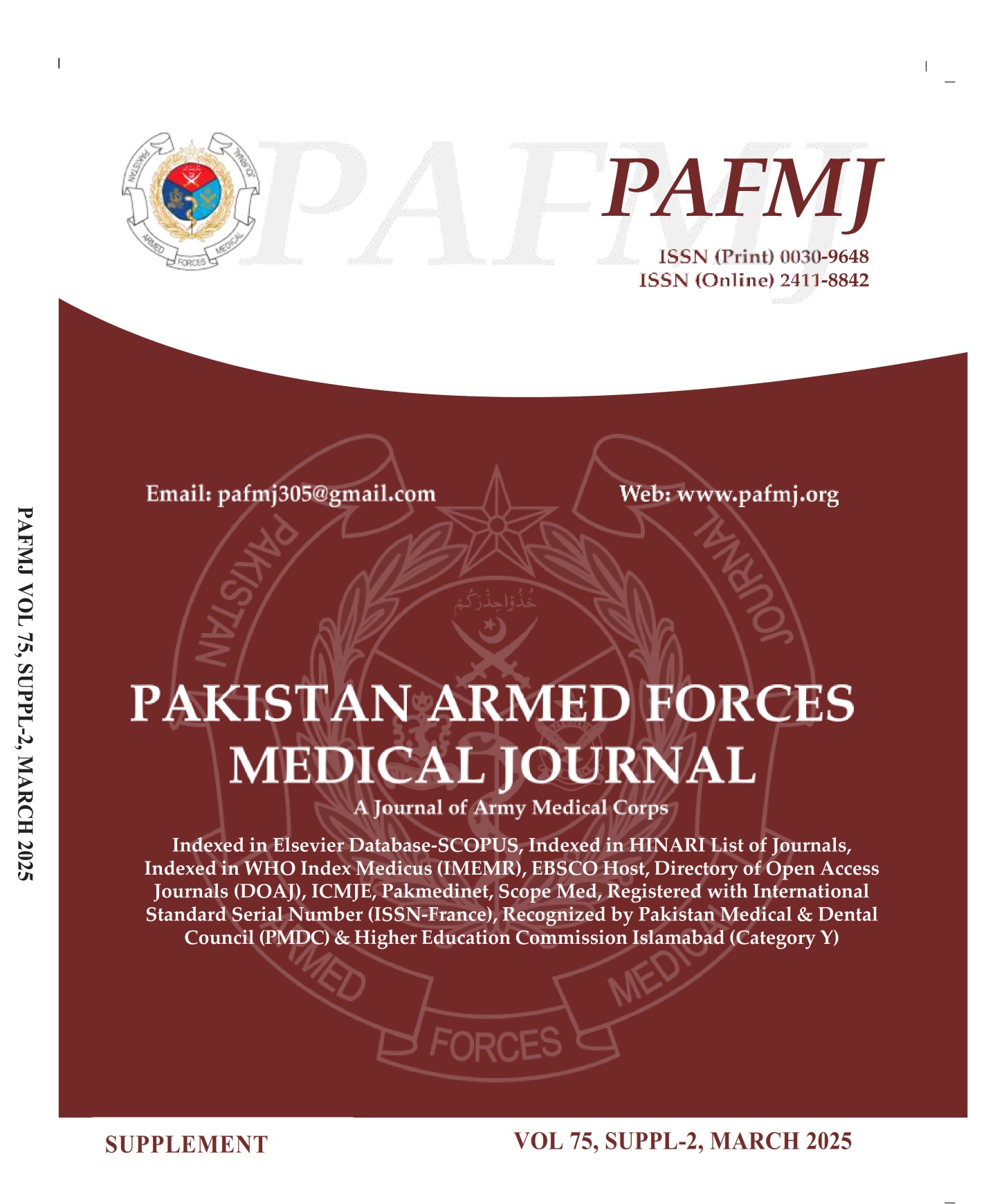Incidence of Determination of Magnitude of Confusion, Disorientation and Encephalopathy in Patients of COVID-19
DOI:
https://doi.org/10.51253/pafmj.v75iSUPPL-2.7072Keywords:
Covid-19, Coronavirus, Confusion, Encephalopathy, Elevated, Neurological.Abstract
Objective: To determine the magnitude of confusion, disorientation, and encephalopathy in patients of COVID-19.
Study Design: Cross-sectional study.
Place and Duration of Study: Pak Emirates Military Hospital, Rawalpindi Pakistan, from May 2020 to Apr 2021.
Methodology: A total of 183 confirmed cases of COVID-19 who presented to our hospital and fulfilled the inclusion criteria were included. A confirmed COVID -19 case was diagnosed using real-time reverse transcriptase-polymerase chain reaction (rRT-PCR). Patient history and examination were done to document the neurologic symptoms. Coronavirus-related encephalopathy and COVID-19 severity were accessed using two distinct criteria. p-value of <0.05 was considered significant.
Results: The majority 110(60.1%) of the patients were between 46 to 70 years of age, and only 39.9% were between 20 to 45 years of age. There were a total of 23(12.6%) severe COVID-19 patients. Among them, 60.9% of severe COVID-19 patients were males Among severe COVID-19 patients, 52.2% had encephalopathy (p-value =0.002), a comparable percentage had confusion (p-value =0.002), and 39.1% has disorientation (p-value =0.032).
Conclusion: Neurological symptoms are more common among patients who had severe COVID-19, disease. Having additional knowledge about neurological symptoms would render physicians in limited resource settings, to focus on a mental health aspect that is usually ignored. This will make them more capable of dealing with COVID-19 patients, and thus providing treatment in a timely and efficient manner.
Downloads
References
Koralnik IJ, Tyler KL. COVID‐19: a global threat to the nervous system. Ann Neurol 2020; 88(1): 1-1.
https://doi.org/10.1002/ana.25807
Zhu N, Zhang D, Wang W, Li X, Yang B, Song J, et al. A novel coronavirus from patients with pneumonia in China, 2019. N Engl J Med 2020 Jan 24.
https://doi.org/10.1056/NEJMoa2001017
Liotta EM, Batra A, Clark JR, Shlobin NA, Hoffman SC, Orban ZS, et al. Frequent neurologic manifestations and encephalopathy‐associated morbidity in Covid‐19 patients. Ann Clin Transl Neurol 2020; 7(11): 2221-2230.
https://doi.org/10.1002/acn3.51210
Garg RK, Paliwal VK, Gupta A. Encephalopathy in patients with COVID‐19: a review. J Med Virol 2021; 93(1): 206-222.
https://doi.org/10.1002/jmv.26207
Naidech AM, Beaumont JL, Rosenberg NF, Maas MB, Kosteva AR, Ault ML, et al. Intracerebral hemorrhage and delirium symptoms. Length of stay, function, and quality of life in a 114-patient cohort. Am J Respir Crit Care Med 2013; 188(11): 1331-1337. https://doi.org/10.1164/rccm.201307-1256OC
Garg RK, Paliwal VK, Gupta A. Encephalopathy in patients with COVID‐19: a review. J Med Virol 2021; 93(1): 206-222.
https://doi.org/10.1002/jmv.26207
Shafait S, Alamgir W, Yousaf MA, Manzar MA, Khattak AL, Yousaf MJ. Neurological Manifestations Of Covid-19 In Patients Admitted At A Tertiary Care Hospital In Punjab, Pakistan. PAFMJ 2020; 70(2): S439-S443.
Berger JR. COVID-19 and the nervous system. J Neurovirol 2020; 26(2): 143-148.
https://doi.org/10.1007/s13365-020-00840-5
Ellul MA, Benjamin L, Singh B, Lant S, Michael BD, Easton A, et al. Neurological associations of COVID-19. Lancet Neurol 2020; 19(9): 767-783.
https://doi.org/10.1016/S1474-4422(20)30221-0
Leonardi M, Padovani A, McArthur JC. Neurological manifestations associated with COVID-19: a review and a call for action. J Neurol 2020; 267(6): 1573-1576.
https://doi.org/10.1007/s00415-020-09896-z
Shafait S, Alamgir W, Yousaf MA, Manzar MA, Khattak AL, Yousaf MJ. Neurological Manifestations Of Covid-19 In Patients Admitted At A Tertiary Care Hospital In Punjab, Pakistan. PAFMJ. 2020; 70(2): S439-S443.
Inouye SK, van Dyck CH, Alessi CA, Balkin S, Siegal AP, Horwitz RI. Clarifying confusion: the confusion assessment method: a new method for detection of delirium. Ann Intern Med 1990; 113(12): 941-948.
https://doi.org/10.7326/0003-4819-113-12-941
Devlin JW, Skrobik Y, Gélinas C, Needham DM, Slooter AJ, Pandharipande PP, et al. Clinical practice guidelines for the prevention and management of pain, agitation/sedation, delirium, immobility, and sleep disruption in adult patients in the ICU. Crit Care Med 2018; 46(9): e825-73.
https://doi.org/10.1097/CCM.0000000000003299
Chen T, Wu DI, Chen H, Yan W, Yang D, Chen G, et al. Clinical characteristics of 113 deceased patients with coronavirus disease 2019: retrospective study. BMJ 2020; 368.
https://doi.org/10.1136/bmj.m1091
Yin R, Yang Z, Wei Y, Li Y, Chen H, Liu Z, et al. Clinical characteristics of 106 patients with neurological diseases and co-morbid coronavirus disease 2019: a retrospective study. medRxiv 2020 Jan 1.
https://doi.org/10.1101/2020.04.29.20085415
Mao L, Jin H, Wang M, Hu Y, Chen S, He Q, et al. Neurologic manifestations of hospitalized patients with coronavirus disease 2019 in Wuhan, China. JAMA Neurol 2020; 77(6): 683-690.
https://doi.org/10.1001/jamaneurol.2020.1127
Hamming I, Timens W, Bulthuis ML, Lely AT, Navis GV, van Goor H. Tissue distribution of ACE2 protein, the functional receptor for SARS coronavirus. A first step in understanding SARS pathogenesis. J Pathol 2004; 203(2): 631-637.
https://doi.org/10.1002/path.1570
Desforges M, Favreau DJ, Brison É, Desjardins J, Meessen-Pinard M, Jacomy H, et al. Human Coronaviruses Respiratory Pathogens Revisited as Infectious Neuroinvasive, Neurotropic, and Neurovirulent Agents. InNeuroviral infections 2013 (pp. 93-121). CRC press.
Al-Osail AM, Al-Wazzah MJ. The history and epidemiology of Middle East respiratory syndrome corona virus. Multidiscip Respir Med 2017; 12(1): 1-6.
https://doi.org/10.1186/s40248-017-0101-8
Kennedy M, Helfand BK, Gou RY, Gartaganis SL, Webb M, Moccia JM, et al. Delirium in older patients with COVID-19 presenting to the emergency department. JAMA Netw Open 2020; 3(11): e2029540.
https://doi.org/10.1001/jamanetworkopen.2020.29540
O’Hanlon S, Inouye SK. Delirium: a missing piece in the COVID-19 pandemic puzzle. Age Ageing 2020 Jul 1.
https://doi.org/10.1093/ageing/afaa094
Burke RM, Killerby ME, Newton S, Ashworth CE, Berns AL, Brennan S, et al. Symptom profiles of a convenience sample of patients with COVID-19—United States, January–April 2020. MMWR Morb Mortal Wkly Rep 2020; 69(28): 904.
Downloads
Published
Issue
Section
License
Copyright (c) 2025 Muhammad Waseem, Malik Nadeem Azam Khan, Asim Saleem, Majida Zia, Saira Musarrat, Sana Uruj

This work is licensed under a Creative Commons Attribution-NonCommercial 4.0 International License.















